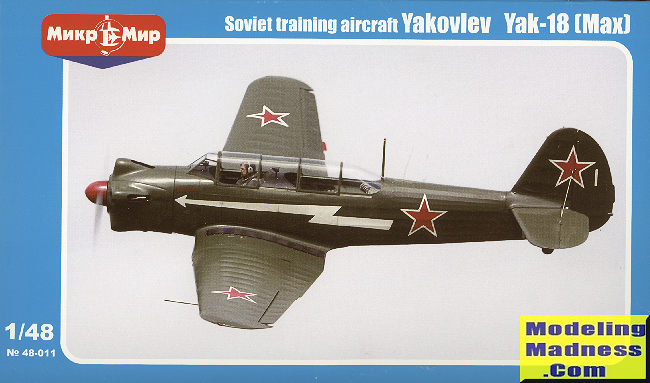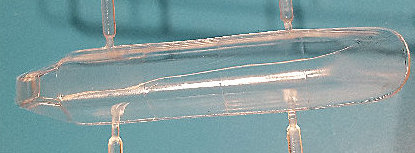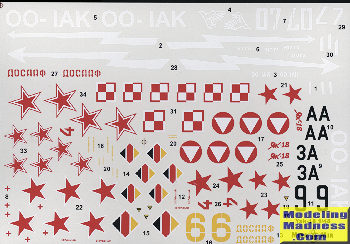
MikroMir 1/48 Yak-18
| KIT #: | 48011 |
| PRICE: | $32.00 delivered |
| DECALS: | Eight options |
| REVIEWER: | Scott Van Aken |
| NOTES: | Short run kit |

| HISTORY |
A member of the second generation of Russian aircraft designers, and best known for fighter designs, Alexander Sergeyevich Yakovlev always retained a light aircraft design section. In May 1945, Yakovlev initiated design of the Yak-18 two-seat primary trainer. He designed it to replace the earlier Yakovlev UT-2 and Yakovlev Yak-5 in service with the Soviet Air Forces and DOSAAF (Voluntary Society for Collaboration with the Army, Air Force and Navy, which sponsored aero clubs throughout the USSR). In 1944, an advanced version of the UT-2 had been built with many of the features of the new Yak-18. The new aircraft flew a year later, powered by a 119 kW (160 hp) Shvetsov M-11 five-cylinder radial engine and featuring pneumatically operated retractable main landing gear and a fixed tailwheel. It entered service as a trainer later that year and was built by Yakovlev up until 1956. Examples were exported to China in kit form beginning in 1950. The Chinese began producing license built copies in 1954 with the designation CJ-5.
The Yak-18's greatest claim to fame is its use as a night bomber by the North Korean Air Force during the Korean War. The aircraft were modified with bomb racks on the wing center section and flew over UN troop locations at night to drop bombs and harass UN forces. The single most successful attack of the North Korean aviation during the war was the destruction of a fuel dump with nearly 5.5 million US gallons (21 million l; 4.6 million imp gal) of fuel in the Inchon area in June 1953 by four or five Yak-18s. The five-cylinder engine reminded many of the US troops of the sound made by early gasoline powered washing machines, earning them the name: "Washing Machine Charlie". The name "Bed Check Charlie" was also used for these night intruders. The Yak-18s, along with Polikarpov Po-2s, became quite a nuisance until US night fighters began shooting them down. One nightfighter crashed shooting down a Bed Check Charlie and another nightfighter rammed its target.
Other claims to fame for the Yak-18 are an international speed record for its class in 1951 as well as being the aircraft used for initial flight training by Yuri Gagarin (1st human in space) and Ken Rowe (No Kum-Sok, who defected from North Korea with a Mikoyan-Gurevich MiG-15 jet fighter during the Korean War). Later, as the need for conventional landing gear trainers abated, Yakovlev re-designed the Yak-18 with retractable tricycle landing gear and an Ivchenko AI-14RF radial engine of 224 kW (300 hp); this was designated the Yak-18A. The design proved exceptionally easy to build and maintain.
There are an estimated 40 original Yak-18s in existence worldwide. Five are currently flyable in the US, three are flyable in Europe, and the Chinese Air Force has one flyable with several other airframes in storage. Approximately four other aircraft worldwide are currently being restored for flight. Many are found in major aviation museums worldwide including the National Air and Space Museum in the USA. The Nanchang CJ-6, produced in China, is sometimes quoted as a variant but is a completely different aircraft designed in China by Bushi Cheng and built by Nanchang Aircraft Company.
| THE KIT |
 The kit arrived from Ukraine in a bubble bag with the kit sprues wrapped in
bubble wrap, the box unassembled and a section of cardboard to keep it from
being bent. Unfortunately, that was insufficient to protect all the parts as
several were knocked from the sprue and the very delicate inner framework pieces
were all broken with some sections broken away. I also found that one of the
exhaust sections was missing as if it had not been there when the kit was
bagged. I contacted the seller and have been told that a replacement will be
sent.
The kit arrived from Ukraine in a bubble bag with the kit sprues wrapped in
bubble wrap, the box unassembled and a section of cardboard to keep it from
being bent. Unfortunately, that was insufficient to protect all the parts as
several were knocked from the sprue and the very delicate inner framework pieces
were all broken with some sections broken away. I also found that one of the
exhaust sections was missing as if it had not been there when the kit was
bagged. I contacted the seller and have been told that a replacement will be
sent.
 Parts are
typical of this company with fairly close sprue gates, flash on some of the
parts, and somewhat 'soft' detailing. A photo etch fret is include for the seat
harnesses, instrument panels, foot troughs on the floor, straps for the rudder
bar, radio faces and brake discs for the wheels. There is a single piece
transparency that is fairly thick. My transparency has an irregular crack
running along most of the upper part, undoubtedly due to the packaging.
Parts are
typical of this company with fairly close sprue gates, flash on some of the
parts, and somewhat 'soft' detailing. A photo etch fret is include for the seat
harnesses, instrument panels, foot troughs on the floor, straps for the rudder
bar, radio faces and brake discs for the wheels. There is a single piece
transparency that is fairly thick. My transparency has an irregular crack
running along most of the upper part, undoubtedly due to the packaging.
 The
cockpit contains most of the photo etch. For some reason, MicroMir wants you to
remove the molded in place foot troughs and replace them with photo etch. Each
of the instrument panels is five pieces with two of those being acetate film
with the instruments on them. Inside the fuselage fit very finely done
framework. Mine will require some repair prior to installation. There are side
consoles to install along with rudder bars and p.e. straps. A rear shelf with
the radios fits in the back and there is an upper divider piece between the
front and rear cockpits. Before closing the fuselage, the seats are installed.
The
cockpit contains most of the photo etch. For some reason, MicroMir wants you to
remove the molded in place foot troughs and replace them with photo etch. Each
of the instrument panels is five pieces with two of those being acetate film
with the instruments on them. Inside the fuselage fit very finely done
framework. Mine will require some repair prior to installation. There are side
consoles to install along with rudder bars and p.e. straps. A rear shelf with
the radios fits in the back and there is an upper divider piece between the
front and rear cockpits. Before closing the fuselage, the seats are installed.
Work then goes to the wing where one installs the shallow wheel wells before attaching the upper and lower wings to the single piece lower sections. The engine is built up with a three piece crank case section, separate cylinders and separate exhaust pipes. As mentioned earlier, one of my exhaust went missing before I even opened the parts bag. Next, a five piece cowling fits over the engine and a p.e. section fits on the very front of the engine. This assembly along with the wing is then attached to the fuselage.
 The next
several steps finish up the process. This includes the installation of rudder
and tailplanes (a butt join for both), the attachment of the prop and spinner
along with the canopy and a clear area just aft of the cockpit. Then the tail
wheel pieces and tailplane struts are installed. This is followed by the landing
gear legs (one of which is broken at the oleo scissors on my kit), wheels and
the radio mast.
The next
several steps finish up the process. This includes the installation of rudder
and tailplanes (a butt join for both), the attachment of the prop and spinner
along with the canopy and a clear area just aft of the cockpit. Then the tail
wheel pieces and tailplane struts are installed. This is followed by the landing
gear legs (one of which is broken at the oleo scissors on my kit), wheels and
the radio mast.
Instructions are adequate but provide no interior or engine painting information so you are on your own in that regard. markings are provided for eight aircraft. Most are in olive green over sky blue. Five are Soviet with one in all red, one in overall light grey and another in a medium grey. Also included are planes from Austria, Poland, and East Germany. The decal sheet looks very nice and is fairly large.
| CONCLUSIONS |
If you have experience with short run kits, this one should not be very difficult. My enthusiasm for the kit is tempered by all the broken parts that I'll have to repair and the fact that the cracked canopy basically makes the kit unbuildable.
| REFERENCES |
https://en.wikipedia.org/wiki/Yakovlev_Yak-18
December 2021
Copyright ModelingMadness.com. All rights reserved. No reproduction in part or
in whole without express permission.
If you would like your product reviewed fairly and fairly quickly, please contact the editor or see other details in the
Note to
Contributors. Back to the Main Page
Back to the Review
Index Page
Back to the Previews Index Page